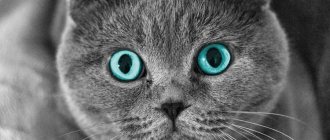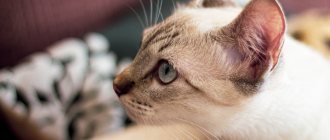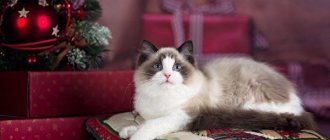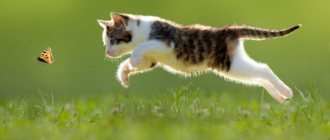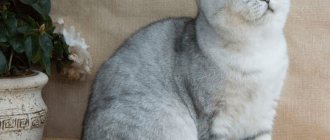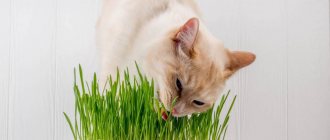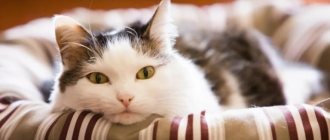Almost every owner of British cat breeds thinks about how to comb their pet, how to do it correctly, and what kind of comb is needed to perform the procedure. An animal's coat is the main indicator of internal and external health. How balanced is your pet’s diet, what micro- and macroelements are missing? One glance at the fur and general appearance of the animal is enough. That is why, for the cat’s health and to maintain a smooth and shiny coat, it should be combed periodically.
Care requirements
Pedigree cats usually require more careful care of themselves.
This is partly true for British longhairs. 1) Nutrition rules. The main principle that should be followed when choosing a diet for your pet is to saturate it with all the necessary vitamins for the growth and development of the coat. In order not to rack your brains, it is recommended to make a choice in favor of professional food, specially selected for this breed.
If the owners feed the British dog homemade food, it is important to know the following rules. Absolutely forbidden:
- give such a cat pork;
- poultry and fish bones;
- peas, beans, lentils;
- potatoes;
- mix professional food and homemade food, since different enzymes of the gastrointestinal tract are responsible for the digestion of such dishes.
Over-salted foods, too fatty foods, smoked foods, sweets and heartily seasoned delicacies are not strictly prohibited. However, consuming too much of this food can cause digestive problems in your cat.
In general, the ideal British diet consists of the following.
- Kittens love dairy products. Growing children can already begin to be given light porridge with milk.
- Adult British Longhairs eat boiled chicken.
- Cats can also enjoy fresh beef.
- Raw quail eggs are considered a real delicacy for them.
- When feeding at home, you should definitely add vitamin complexes to the diet, especially compositions for caring for the coat.
In general, such cats do not require any special care. Unless the owners should take care of the quality of the wool. The British love to comb their hair. To help your cat with this, you should use a brush with a rubber tip.
When your pet sheds, which usually happens in the spring and summer heat, he can be given special medications that accelerate the loss of old hair and stimulate the growth of new hair. If you don’t take care of your Briton at this time, don’t comb him regularly and don’t bathe him with shampoos to remove hair, then the pet will leave tufts all over the apartment.
From the point of view of the animal's health, this is not dangerous, but molting causes understandable inconvenience for the owners. If a cat sheds more often than twice a year, and this happens not in the spring and late summer - early autumn, but in another period, perhaps the pet has some health problems and it is better to take it to the veterinarian.
An important feature of caring for long-haired British cats is the need to use only special shampoos for this type of breed when bathing the animal. They are not uncommon and are sold in any pet store, but their use will significantly reduce the likelihood of possible problems with the coat.
British cats have fast growing claws. If they are not processed in time, they may break off. For an animal, a broken claw is a trauma, so it is better to avoid this by regularly giving your pet a manicure or allowing him to sharpen his claws on his own on some designated object.
Review of popular models
The most popular furminator models on the modern market, which have deservedly received the highest ratings from users:
- FURminator deShedding;
- HelloPet;
- TRIXIE;
- Dele.
It is better to purchase the first three brands in specialized stores or grooming salons to avoid counterfeits.
FURminator deShedding
It is considered the most expensive and high quality. The material of the trimmer teeth is high quality steel. The handle is made of eco-rubber with a special application according to the “anti-slip” formula.
In the “classic” version, the cost of the device is about 1,800 rubles.
The “deluxe” modification with an ejector button for removing hair from teeth ranging from 2,100 to 3,000. The comb sizes are available for kittens, small animals and large cats. Due to high-strength materials, it has a long service life.
Trimmer comb TRIXIE
Made from materials with a shorter service life, but has a better price-quality ratio and enjoys well-deserved popularity. The cost of the product, depending on the size of the comb and teeth, is from 900 to 1,500 rubles.
The overall dimensions of the product are 7×15 centimeters. The handle is made of rubberized material and does not slip. Users note the lightness of the device and its ease of use.
HelloPet
Equipped with a handle and trimmer blade made of impact-resistant materials. The comb width is 65 mm, the number of teeth is from 60 to 97 for animals of different types of wool and dimensions. The cost of the device, depending on the size and frequency of the trimmer comb, is from 1,200 to 1,800 rubles.
Dele
This popular Chinese product can be bought on Aliexpress. Available in modifications S, M and L, having blade lengths of 5, 6.6 and 10 centimeters, respectively.
A small and lightweight device will last much less than the expensive FURminator, but its advantage is ease of use and low cost.
The cost, depending on the modification, is from 380 to 515 rubles.
Dry cleaning
| Not all cats like to take baths |
It also happens that the cat cannot be washed. Some are afraid of water, others cannot stand the smell of shampoo, others simply by nature do not like all kinds of procedures. What then should be done with such animals? There is a solution - dry shampoo. It does not require pre-wetting the wool or rinsing it off. You simply apply shampoo to the animal's fur, leave it for the time specified by the shampoo manufacturer, and then carefully comb it out of the cat's skin.
It is very important. It is necessary to remove the shampoo without any residue
Otherwise, the cat may lick it, which could lead to poisoning. If you do not have the opportunity to buy such shampoo, you can prepare it yourself from bran at home. You just need to dry the bran in the oven and then rub it into the cat's skin. After this, comb the animal thoroughly and that’s it. The process is over. After this procedure, the cat's fur becomes clean and shiny.
How to comb your pet: what do you need to know about grooming?
When buying kittens, hardly anyone thinks about the need to purchase care products in the first months. However, when the molting period approaches, this issue becomes acute.
It is important to accustom your cat to a hairbrush from childhood, in this case there is a greater chance of avoiding aggression from the pet, and proper brushing will cause a satisfied purr from a pleasant massage
There is a variety of Scottish cat breeds - the Scottish Straight, which is very undemanding in care. The appearance resembles a teddy bear, which is why the breed is very popular. The British is an equally popular breed; cats are very clean by nature, since this feature is inherent at the genetic level
However, it is important to properly raise an animal from childhood.
Caring for British cat breeds
Ungroomed fur of an animal can lead to various skin diseases.
There is a lot of lint from such breeds. Due to the fact that uncombed fur often gets tangled, forming dense balls (tangles), it is considered a breeding ground for unwanted microorganisms on the animal’s body - fleas, ticks, fungal infections, which is why careful care is necessary. When wet, the mat does not dry well, which leads to irritation of the skin around it, and also increases the risk of injury to the animal, because a stray ball of fur can get caught on something and, when unraveling, the cat will be injured
That’s why it’s so important to monitor the condition of your pet’s fur and brush it systematically.
Most owners believe that it is better to clean the apartment one more time than to scratch the cat and be scratched by sharp claws. On the one hand, this is correct, but on the other hand, it is dangerous, since swallowed lint is not removed from the body naturally, but is regurgitated. Insufficient regurgitation and a large number of wool particles clog the cat’s intestines, which, in turn, threatens a trip to the veterinary clinic. There is an alternative method - a specially developed paste used to remove fur hairs accumulated by daily washing.
This is interesting: Breed of cats with short hair: study in detail
Combs for the British
Every loving animal owner thinks about which comb to choose for his British cat. On the shelves of pet stores there is an incredible variety of such items that can be selected according to the individual preferences of the owner of the furry animal, for every taste and budget. There are different types of combs:
Such a device can be made in the form of a mitten.
- with Teflon coating;
- comb rake;
- with stainless steel teeth;
- with rotating teeth;
- comb with multi-level teeth;
- brush-mitten.
The length of the brush teeth is selected depending on the length of the pet’s coat; it is very convenient that this information is indicated on the product packaging. The hair of the British is quite short, so that all of the above combs can be used; caring for the delicate fur of this type of breed can be replaced by regular wiping with a wet hand. As a result of this procedure, much more hair is removed than with brushes. The British fur coat is the main advantage of a cat, which is why care should be as thorough and effective as possible.
Furminator and its types
This is a very popular miracle tool for combing the coat of a British cat, and the process does not cause discomfort to the animal, and more often, even the opposite. There are two types of furminators - classic type and deluxe. The only difference between these varieties is the presence of a FURejector button in the deluxe line for automatically removing hair from the comb. Each of them is designed separately for each type of cat - short-haired and long-haired.
There are devices for animals with short and long hair.
Before brushing your cat with a furminator, you must comply with the following conditions:
- It is advisable to bathe the animal and dry the fur before the procedure.
- Do not use if there are lesions or wounds on the skin.
- Before the procedure, comb with a regular brush.
- Cut off all tangles using scissors.
- Start combing slowly according to hair growth. Particularly carefully comb the area of the abdomen and anus.
Character of British cats
Representatives of the British cat breed love tranquility. They have a friendly and gentle character. However, the British do not like to be held - they often decide for themselves how much they can be stroked and held in their arms. However, the cat’s peculiar habits do not prevent him from being a devoted friend of his owner.
They love to play and catch mice in the house.
| Character | Calm, friendly |
| Suitable for home | Fits good |
| Tolerates loneliness | Well tolerated |
| Postpones the move | Doesn't tolerate well |
| Street | Not afraid, can stay in nature for a long time |
| Relationship with the owner | Chooses one owner |
| Relationship with children | Gets along well |
| Relations with guests | Gets along well |
| Relationship with other cats | Gets along very well |
| Relationship with dogs | Gets along well |
Character and habits of British cats >>
To prevent a British cat from developing bad habits, it must be trained from an early age. This breed is fairly easy and quick to train, so there shouldn’t be any problems. When you catch a kitten at the “crime scene,” try to tell him command words in a firm voice.
Moreover, it is better if these are pre-prepared, short and sonorous phrases that you will repeat every time if the situation repeats. Simultaneously with the words, show the kitten the action that he needs to perform. Thus, raising a Briton will be brilliant by the age of 2!
Advantages
Manufacturers of furminators advertise their products, listing the following advantages when used for combing cats:
- there is no injury to the animal’s skin;
- do not cause pain to the cat;
- healthy guard hairs are not damaged during the combing process;
- removal occurs in the right places and only dead parts of the undercoat;
- using the device helps prevent the occurrence of tangles;
- the animal gets used to combing painlessly and quickly;
- the pet enjoys the procedure;
- due to the effective removal of loose hair, the cat swallows less hair when licking;
- the molting period is effectively reduced;
- at the same time the skin is massaged;
- The source of pollution in human housing is promptly eliminated.
Washing the cat
A domestic cat of this breed must be washed when it gets dirty, but not more than twice a month. This procedure is best done together. Sometimes it’s impossible to cope alone. Before you start washing, make sure you have everything you need at hand: cat shampoo, conditioner, eye and nose balm. It is better to bathe a cat in a filled sink or bathtub. The water level should not be higher than the cat's belly when you place it in the water. Water temperature 37-38 degrees, without adding foam or detergents. After you fill the bathtub or sink with water, place the cat in it and gently wet its skin with your hands - running water from a tap or shower will only scare it. Then apply shampoo, rub it well into the coat, then rinse with smooth movements. It is better if a second person waters the cat from a jug or watering can. If this is not possible, you can use a shower with low water pressure. The cat's head and face are washed last, using special products, avoiding getting water and shampoo into the ears. At the end of the procedure, apply conditioner to the cat's fur, rinse it thoroughly if necessary. Then wrap the cat in a large towel, preferably warm, and hold it there for 10-15 minutes so that all excess moisture is absorbed. Take your time to take your cat out of the bathroom, especially if the temperature in the apartment or house is below 24 degrees.
Operating rules
There are no rules regarding the use of combs. The main thing is to use the tool strictly for its intended purpose - combing wool.
Before you start brushing, you need to bathe your cat with shampoo, but do not use hair conditioner.
The use of a comb does not require any specific skills from the cat owner. You just need to follow the general recommendations:
- For the procedure, you need to choose a place that will then be easy to remove. There will be a lot of wool. To simplify the cleaning procedure, the cat can be placed on a bedding.
- If there are tangles in the wool, they need to be removed. You can try to sort out the lumps - if they are not very matted - or cut them off with scissors if they have become real felt.
- You need to comb your pet strictly in the direction of hair growth. Not only will your cat not like brushing in the opposite direction, but it can also damage the structure of the guard hair.
- There is no need to press the comb too hard during the procedure.
- When treating the surface of the abdomen and groin area, you must be as careful as possible. These parts of the body are very sensitive and if the cat doesn't like something, it may scratch or bite.
Feeding
Proper nutrition is also a kind of cat care, because the general condition of the animal and its appearance largely depend on it. For good health, well-being and an impeccable appearance, a British cat needs not only a balanced diet, but also a certain regime. Do not forget that the British are dense and massive carnivores, whose main food should be protein food. For your cat's diet, you can use the scheme developed in one of the British breeding nurseries. So, experts recommend the following schemes.
For kittens from two to four months
- Breakfast – a little unsweetened cottage cheese without additives with a fat content of no more than 5%
- Second breakfast – boiled chicken or canned meat for baby food
- Lunch – dry food for kittens
- Dinner – finely chopped, planed or minced raw meat (lean beef, veal)
For cats four months and older
- Breakfast – cottage cheese without additives and sugar with a fat content of up to 5%, a little boiled chicken meat
- Lunch – dry food
- Dinner – raw meat
Naturally, your cat should always have a bowl of clean water.
Of course, the proposed scheme is not a guide to action and not the only possible diet option. Cats, like people, have different taste preferences. Therefore, you can create a menu for your pet yourself, including fermented milk products, vegetables and fruits, cereals and fish. But you must always know and remember what you cannot feed cats of any breed. So, you should not include the following foods and ready-made food in your cat’s diet.
- Ready-made dog food, as well as specialized types of food for other purposes. That is, you should not give your cat food for pregnant cats, or adult animals food for kittens.
- Bones (except beef marrow for cleaning teeth). Poultry or fish bones can injure the intestines, become lodged in the esophagus, and even cause suffocation.
- River or raw fish. It has been proven that eating the fish so beloved by cats disrupts the functioning of their urinary system and contributes to the formation of kidney stones. If you give fish to your cat, then you should do this infrequently and give preference to boiled, low-fat sea fish.
- Fresh milk, butter, cheese. All this can cause intestinal upset with unpleasant consequences.
- Smoked, fried, pickled, canned, spicy, sweet, fatty, spicy, salty foods. In a word, everything that we most often use to prepare food for ourselves. Food from our table is simply dangerous for cats!
And most importantly, follow the three basic principles of feeding your British dog: consistency, separateness and naturalness. Don't forget that only proper nutrition and attentive care will help keep your cat healthy. But only a healthy and well-groomed animal is able to make a show career or become a progenitor or successor of a breeding line. However, if your cat is not of elite blood and impeccable appearance, then you still need to take care of it. After all, we are responsible for those we have tamed.
British longhair cats
The British Longhair is considered a semi-longhaired variation of the British Shorthair. In Europe, this breed is increasingly called the Highlander or Britanica, but in America it is better known as the Lowlander.
And although fluffy British cats with long hair have existed for a long time, they were officially recognized only in August 2008, under the WCF system at the General Assembly. Until this time, long-haired kittens that were born from short-haired cats were considered PET. Such kittens could not be crossed with their short-haired counterparts and should not be allowed to be bred.
However, over time, lovers of the breed were still able to achieve recognition of the long-haired British bear-type not only in the WFC felinological association, but also in TICA. This type of breed is not yet recognized in other organizations, but is considered experimental.
The main difference and feature of a long-haired British cat from a short-haired one is the medium-length hair, which often increases from head to tail. Regardless of whether the cat is blue, chinchilla, or black Briton, the coat always has a double, ivy-like structure and dry guard hairs. In addition, if the pedigree of a long-haired British cat does not contain Persian cats, then its fur will never become tangled and therefore the care and maintenance of a British cat will not require much time. And these cats are completely unpretentious when it comes to food.
How to name a British kitten >>How to name a kitten based on the length of its fur >>
Article information
This article was co-authored by. Dr. Elliott, BVMS, MRCVS is a veterinarian with over 30 years of experience in veterinary surgery and the care of companion animals. She graduated from the University of Glasgow in 1987 with a degree in Veterinary Medicine and Surgery. He has been working at the same animal clinic in his hometown for over 20 years.
In other languages:
Español: cuidar las patas de un gato, Italiano: Prendersi Cura delle Zampe del Gatto, Français: prendre soin des pattes d'un chat, Deutsch: Die Pflege von Katzenpfoten
This page has been viewed 4375 times.
Was this article helpful?
Not really
( 1 rating, average 4 out of 5 )
Possible health problems
Most cats have a natural predisposition to certain diseases. This largely depends on the breed. The following problems are typical for British cats with long hair.
- Quite often, cats develop cardiomyopathy - a structural defect of the heart that is not associated with infection and does not affect blood supply, but can provoke more dangerous diseases.
- Together with their short-faced relatives, the British often encounter tartar, so regular oral care is essential for this breed.
- The structure of your pet's body makes him prone to the problem of excess weight.
In general, the British do not get sick any more often than their feline counterparts of other breeds. Many experts even claim that these cats are distinguished by their strength and health.
What does a British cat need in an apartment?
Before purchasing a kitten, you need to carefully prepare the required accessories. You need to buy a place where the pet will rest. The British prefer to sleep on their own, so you need to take a bed or a special house.
You will definitely need to purchase a tray for your little kitten to go to the toilet. It is best to buy a pot made of plastic material and a closed type. It must have high sides and be comfortable. The filler is purchased with silica gel or with wood capsules, this will help absorb moisture well and eliminate odor.
The bowl for drinking liquid should be made of ceramic material. For food, it is best to take one made from mathematical material and with a wide bottom. British cats do not like to damage the furniture in the house, so you need to purchase a scratching post. It would be good to buy a special play area for your cat.
Massage brushes are well suited for plush wool; they are called slickers; they best remove static electricity. If your pet goes out for walks, you can buy him an interesting wardrobe. This breed does not withstand the cold well, as they are short-haired. The outfit you purchase is of high quality and comfortable for your pet. If everything is done correctly, the animal will feel comfortable and cosy.
Where to buy a furminator
It is best to purchase the device in trusted places where they can give a guarantee on the device.
- At a veterinary pharmacy or pet store. Despite the fact that the cost at such points is slightly higher, sellers are always responsible for the quality of their products, and this is of great importance. In addition, experts will be able to advise which Furminator is best to buy for a particular Briton.
- In the online store. Nowadays, there are enough online outlets that sell products for animals. The cost of the device can be an order of magnitude lower. At the same time, you should pay attention to the manufacturer. Although high-quality devices are more expensive, they operate for 6-7 years. Cheap analogues often last no more than a year. Many users turn to foreign stores where they make purchases.
- Large hypermarkets, like Auchan. Furminators can be found at such points, but many pet owners complain about the small range of products.
Source
History of the breed
The emergence of the longhaired British cat as a separate breed can be considered spontaneous, since for a long time it was culled from litters. In Great Britain, only pets with short hair were considered purebred. The British Longhair was officially recognized only in the 20th century. However, the beginning of selection is considered to be 1889, when the first cat was presented at the exhibition.
After World War II, the number of purebred British breeds declined critically. As a result, it was decided to cross them with Persians and Somalis. The second goal was to obtain new colors. However, as a result, a recessive gene (DR) for long hair appeared. It quietly began to be passed down from generation to generation. As a result, more and more British Longhairs appeared in litters.
Gradually they began to be removed purposefully. In 2001, Highlanders were recognized as a new experimental breed by the International Cat Association (TICA). Its clear standards were developed in 2004. Since 2009, British Longhairs have been recognized by the World Cat Federation and began to receive championship titles.
Character traits
The true character of a British cat emerges as it matures. The kids of Foggy Albion are still as active and cheerful as their relatives. However, a sexually mature individual acquires truly aristocratic calm and tact. It is difficult to scare or enrage a Briton. The animal expresses negative emotions with a silent protest: it can hide somewhere, consciously avoid its owners, but no aggression should be expected from it.
Such cats get along well with other pets, but do not tolerate small children who will pester the animal too actively. The British usually hide in secluded places from overly active children.
An aristocratic cat does not like to be pampered, so even when leaving it alone in the apartment, the owners do not have to worry about the integrity of the vases and curtains.
Grooming
Caring for British cats is quite simple. Take a few minutes a day to care for your coat and eyes. Trim your cat's claws 2-3 times a month and remove dirt from the ears.
To make the new family member feel comfortable in the house, it is recommended to purchase all the necessary accessories and toys in advance.
Accessories
- Tray. The British toilet can be either open or closed. It is recommended to purchase a spacious tray with filler.
- Bowl for food. For British cats, any bowl with a wide bottom is suitable.
- Water bowl. The drinking bowl should be large. A dog bowl works great.
- Comb. A metal brush with sparse and rounded teeth will be just right for a Briton.
- Sleeping area. A cat house is perfect for a British kitten, where he can play, sleep and even sharpen his claws.
Frequency of use and benefits of products
This event is recommended to be carried out once or twice a month for British cat breeds. In summer, using a furminator will carefully remove excess undercoat. It is also necessary to comb out during the molting period - the beginning of spring and autumn - two to three times a week. Advantages of Furminators for a Briton:
With this device you don’t have to resort to cutting the animal.
- Reducing the amount of hair falling out, minimizing mats and mats.
- Savings on visits to grooming salons.
- Due to the correct distribution of fatty lubricant, the appearance of the animal's fur coat is significantly improved - it becomes beautiful and shiny.
- Easier cleaning due to reduced amount of hair loss.
Thus, each cat owner himself chooses what is best for a furry animal - a comb for a British cat, a brush-mitten, or simply removing hair with a damp cloth - after all, the main thing is that the care is correct. That’s why it’s so important to carefully care for your pet’s fur coat - he, in turn, will not remain in debt and will repay you with love for your care.



